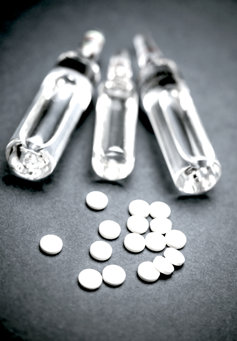Synthetic Opioids —The Drugs Responsible for Most of the Overdose Deaths in 2017

The U.S. struggles in the grip of an opioid crisis—perhaps the worst addiction epidemic that our nation has ever seen.
And in the last few years, a new strain of opioids has entered the scene, creating a surge in the addiction crisis and a resulting spike in the death toll.
This is speaking of course of synthetic opioids, the new group of opioid drugs that was single-handedly responsible for almost half of all opioid deaths in 2016 and almost one-third the total number of all drug deaths for that year.
What Are Synthetic Opioids, and Why Are They So Dangerous?
The terminology for addictive drugs can get a little confusing, especially when new strains and types of drugs are constantly being added to the list. But synthetic opioids are quite easy to define. In fact, the Centers for Disease Control and Prevention has perhaps the best definition for synthetic opioids. According to their data:
“Synthetic opioids are a class of drugs that are designed to provide pain relief, mimicking naturally occurring opioids such as codeine and morphine. They tend to be highly potent, which means only a small amount of the drug is required to produce a given effect.
“They include drugs like tramadol and fentanyl. … Although synthetic opioids are manufactured by pharmaceutical companies, they are also manufactured illegally in clandestine labs and distributed through the illicit drug market.”
The most common synthetic opioid is fentanyl, a man-made opioid drug which is 50 times more potent than heroin and 100 times more potent than morphine, according to the CDC.
The CDC also offers insight on the two different types of fentanyl—the legal kind, and the illegal kind. According to the CDC, legal fentanyl is pharmaceutical grade fentanyl which is prescribed to manage severe pain. Illegal fentanyl is not made by pharmaceutical companies. Instead, it is made in clandestine drug labs and then sold on the streets as a recreational drug. It is often cut with heroin, cocaine, or other chemicals to make it more potent (and more lethal).

Let’s be very clear about something. A synthetic opioid is classified as such because of the totally man-made variant that is added to the manufacturing process. Synthetic opioids are entirely made in laboratories with chemical synthesis. This is different from other opioid drugs like morphine and codeine which are extracted from naturally-occurring chemicals in opium leaves. Fentanyl is a synthetic opioid, but so is oxycodone or hydrocodone.
Synthetic opioids are dangerous because they are extremely potent. There is nothing organic or natural about them. They are entirely man-made and they possess several times the potency of naturally-occurring opioids.
For example, the most common synthetic opioid is fentanyl, and as mentioned above, fentanyl is more powerful than traditional opiates like morphine and codeine, and it’s more potent than pure heroin. Just a little dose of synthetic opioids is enough to kill even an experienced drug user.
Statistics on Synthetic Opioid Addiction
The statistics on synthetic opioid use, addiction, overdose, and death are all pretty concerning. This is a drug which currently accounts for the largest share of drug overdose fatalities in the U.S., according to the National Institute on Drug Abuse. In fact, according to NIDA:
- 2016 was the first year when synthetic opioids surpassed prescription opioids as the most common drug involved in overdose deaths in the U.S. In fact, synthetic opioids accounted for 19,413 of the roughly 64,000 drug-related deaths in 2016.
- Another factor is the rate at which these drugs are taking lives. 19,413 people died from synthetic opioid use in 2016, compared to 3,007 deaths from synthetic opioids in 2010. So in only six years, the overdose rate for synthetic opioids increased by more than 600%.
- Even when compared to other opioid deaths, which have also been increasing dramatically, synthetic opioids are still the fastest growing problem. A total of 42,249 people died from opioid-related causes in 2016. 15,469 died from heroin overdoses, 17,087 died from prescription opioids, and 19,413 died from synthetic opioids.
Clearly, we have a big problem on our hands with synthetic opioids. Not only is this the number one cause of death on the drug scene, but the rate at which this class of opioids has soared to the top in lethality is particularly concerning.
How Can We Reduce the Death Toll from Synthetic Opioids?

The National Institute on Drug Abuse completes their presentation on synthetic opioids by giving us six routes that we can all work on. These routes, if pursued in tandem, will result in a reduction of both synthetic opioid misuse and the overall opioid crisis.
These are all good strategies, and they will serve to help us if we pursue them with diligence and consistency.
These are:
- Improve access to treatment and recovery services. If we want to help people break free from their addictions to substances, we will have to give them a way out of the trap, and that way out starts with access to inpatient, residential addiction treatment programs. While not all inpatient addiction treatment centers offer the same level of care or the same degree of services, inpatient centers generally provide the most comprehensive and helpful recovery options.
- Promote the use of overdose-reversal drugs like naloxone. Naloxone, branded as Narcan, is an emergency medicine which when applied to an overdosing addict is able to essentially “bring the addict back to life.” Naloxone halts the effects of an opioid overdose, truly pulling an addict back from the brink of death. The more naloxone that is made available, the more drug deaths will be prevented.
- Strengthen our understanding of the opioid epidemic through better public healthcare surveillance. One of the reasons why the opioid epidemic got so out of hand was because it was allowed to get out of hand for years before our nation got wise to the crisis. Plain and simple, we need better organization in our healthcare system, better observation of the health of our citizenry, and better watchdog programs that sound the alarm when a health crisis forms.
- Provide research on pain and addiction. Addiction is a highly “unknown” topic. According to a paper at the National Council on Alcoholism and Drug Dependence, “Only about 1,200 of the 985,375 practicing doctors in the United States are trained in addiction medicine.” We need to research addiction, garner more information about it, and use that research to find cutting-edge solutions to both addiction and pain.
- Advance better practices for effective pain management. What got us into this mess with opioids was an incessant demand from the pharmaceutical and medical industries to address patient pain. We picked the wrong tool to address that pain. We need to research and innovate new and better ways to address patient pain using methods and techniques which won’t land us in a bigger problem in the way the opioid pain-reliever “solution” did.
The road to creating a nation that is safe from the opioid threat is going to be a long one, and it’s going to have potholes in it. Let’s try and remember that we did not get into this condition overnight. It took about twenty years for the opioid crisis to get this bad. It’ll take some time to work our way out of this problem, but doing so is possible. The sooner we commit to this and take action the better off we’ll all be.
Sources:
- https://www.cdc.gov/drugoverdose/data/fentanyl.html
- https://www.drugabuse.gov/related-topics/trends-statistics/infographics/fentanyl-other-synthetic-opioids-drug-overdose-deaths


 ®
®